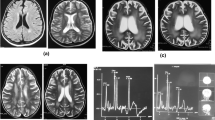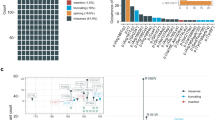Abstract
In the cblF defect of vitamin B12 (cobalamin) metabolism, cobalamin is trapped in lysosomes. Consequently, cobalamin coenzyme synthesis is blocked, and cofactors for methionine synthase and methylmalonyl-coenzyme A (CoA) mutase are deficient. We recently identified LMBRD1 as the causative gene located on chromosome 6q13 and showed that 18 out of 24 alleles in unrelated patients carried the deletion c.1056delG (p.L352fsX18) (Rutsch et al. (Nat Genet 41:234–239, 2009). LMBRD1 encodes the lysosomal membrane protein LMBD1, which presumably facilitates lysosomal cobalamin export. Our patient is the second child of consanguineous Turkish parents. He presented on the second day of life with cerebral seizures due to intraventricular hemorrhage. Plasma homocysteine and urinary methylmalonic acid levels were elevated, and serum cobalamin level was decreased. Synthesis of both cobalamin coenzymes was deficient in cultured skin fibroblasts. The cblF defect was confirmed by somatic complementation analysis. Sequencing of LMBRD1 revealed the novel deletion c.1405delG (p.D469fsX38) on both alleles. Real-time polymerase chain reaction (PCR) revealed reduced messenger RNA (mRNA) levels in patient fibroblasts compared with controls. Transfection of patient fibroblasts with the LMBD1 wild-type complement DNA (cDNA) rescued coenzyme synthesis and function, confirming this new deletion as an additional cause of the cblF defect. This case adds to the spectrum of clinical presentations and mutations of this rare disorder of lysosomal transport.

Similar content being viewed by others
Abbreviations
- AdoCbl:
-
Adenosylcobalamin
- LMBRD1, LMBD1:
-
LMBR1 domain containing 1
- LMBR:
-
limb region 1
- LIMR:
-
lipocalin-interacting membrane receptor
- MeCbl:
-
Methylcobalamin
References
Ariani F, Mari F, Pescucci C, Longo I, Bruttini M, Meloni I, Hayek G, Rocchi R, Zappella M, Renieri A (2004) Real-time quantitative PCR as a routine method for screening large rearrangements in Rett syndrome: report of one case of MECP2 deletion and one case of MECP2 duplication. Hum Mutat 24:172–177
Bailey EJ, Bricker D (1986) A psychometric study of a criterion-referenced assessment instrument designed for infants and young children. Journal of division for early childhood 10:124–134
Campbell CD, Ganesh J, Ficicioglu C (2005) Two newborns with nutritional vitamin B12 deficiency: challenges in newborn screening for vitamin B12 deficiency. Haematologica 90(12 Suppl):ECR45
Clark RM, Marker PC, Kingsley DM (2000) A novel candidate gene for mouse and human preaxial polydactyly with altered expression in limbs of Hemimelic extra-toes mutant mice. Genomics 67:19–27
Coelho D, Suormala T, Stucki M et al (2008) Gene identification for the cblD defect of vitamin B12 metabolism. N Engl J Med 358:1454–1464
Flower DR (1996) The lipocalin protein family: structure and function. Biochem J 318(Pt 1):1–14
Fowler B (1998) Genetic defects of folate and cobalamin metabolism. Eur J Pediatr 157(Suppl 2):S60–S66
Gailus S, Fowler B, Nexo E, Sander S, Marquardt T, Rutsch F (2007) The cobalamin F defect: a rare disease of the lysosome. J Inher Metab Dis 30(suppl 1):134
Hogeveen M, Blom HJ, Van Amerongen M, Bogmans B, Van Beynum IM, Van De Bor M (2002) Hyperhomocysteinemia as risk factor for ischemic and hemorrhagic stroke in newborn infrants. J Pediatr 141:429–431
Kim J, Gherasim C, Banerjee R (2008) Decyanation of vitamin B12 by a trafficking chaperone. Proc Natl Acad Sci U S A 105:14551–14554
Marble M, Copeland S, Khanfar N, Rosenblatt DS (2008) Neonatal vitamin B12 deficiency secondary to maternal subclinical pernicious anemia: identification by expanded newborn screening. J Pediatr 152:731–733
MacDonald MR, Wiltse HE, Bever JL, Rosenblatt DS (1992) Clinical heterogeneity in two patients with cblF disease (Abstract). Am J Hum Genet 51(suppl):A353
Petäjä J, Hiltunen L, Fellman L (2001) Increased risk of intraventricular hemorrhage in preterm infants with thrombophilia. Pediatr Res 49:643–646
Rosenblatt DS, Cooper BA (1990) Inherited disorders of vitamin B12 utilization. Bioessays 12:331–334
Rosenblatt DS, Hosack A, Matiaszuk NV, Cooper BA, Laframboise R (1985) Defect in vitamin B12 release from lysosomes: newly described inborn error of vitamin B12 metabolism. Science 228:1319–1321
Rutsch F, Gailus S, Miousse IR et al (2009) Identification of a putative lysosomal cobalamin exporter altered in the cblF defect of vitamin B12 metabolism. Nat Genet 41:234–239
Shih VE, Axel SM, Tewksbury JC et al (1989) Defective lysosomal release of vitamin B12 (cblF): a hereditary cobalamin metabolic disorder associated with sudden death. Am J Hum Gen 33:555–563
Suormala T, Baumgartner MR, Coelho D et al (2004) The cblD defect causes either isolated or combined deficiency of methylcobalamin and adenosylcobalamin synthesis. J Biol Chem 279:42742–42749
Vassiliadis A, Rosenblatt DS, Cooper BA, Bergeron JJ (1991) Lysosomal cobalamin accumulation in fibroblasts from a patient with an inborn error of cobalamin metabolism (cblF complementation group): visualization by electron microscope radioautography. Exp Cell Res 195:295–302
Waggoner DJ, Ueda K, Mantia C, Dowton SB (1998) Methylmalonic aciduria (cblF): case report and response to therapy. Am J Med Gen 79:373–375
Wang YH, Chang SC, Huang C, Li YP, Lee CH, Chang MF (2005) Novel nuclear export signal-interacting protein, NESI, critical for the assembly of hepatitis delta virus. J Virol 79:8113–8120
Watkins D, Rosenblatt DS (1986) Failure of lysosomal release of vitamin B12: a new complementation group causing methylmalonic aciduria (cblF). Am J Hum Genet 39:404–408
Wojnar P, Lechner M, Merschak P, Redl B (2001) Molecular cloning of a novel lipocalin-1 interacting human cell membrane receptor using phage display. J Biol Chem 276:20206–20212
Wojnar P, Lechner M, Redl B (2003) Antisense down-regulation of lipocalin-interacting membrane receptor expression inhibits cellular internalization of lipocalin-1 in human NT2 cells. J Biol Chem 278:16209–16215
Wong TK, Rosenblatt DS, Applegarth DA (1992) Diagnosis and treatment of a child with cblF disease. Clin Invest Med 15:A111
Acknowledgments
The authors thank Ulrike Botschen for expert technical assistance and Torsten Stölting for graphical assistance. SG and FR are supported by funds from “Innovative Medical Research”, Münster University, Germany. FR is supported by the Interdisciplinary Center for Clinical Research, Münster, Germany. TS, MS, and BF are supported by a grant from the Swiss National Foundation (320000-122568/1).
Author information
Authors and Affiliations
Corresponding author
Additional information
Communicated by: Johan van Hove
Julia B. Hennermann and Frank Rutsch contributed equally to the study.
Accession codes:
cblF disease: OMIM #277380; GenBank: LMBRD1, 55788; LMBD1, NP_060838.2; LMBR1, NP_071903; LIMR, NP_060583
Electronic supplementary materials
Below is the link to the electronic supplementary material.
Supplementary Table 1
(GIF 48 kb)
Supplementary Table 2
(GIF 151 kb)
Supplementary Figure 1
(DOC 139 kb)
Rights and permissions
About this article
Cite this article
Gailus, S., Suormala, T., Malerczyk-Aktas, A.G. et al. A novel mutation in LMBRD1 causes the cblF defect of vitamin B12 metabolism in a Turkish patient. J Inherit Metab Dis 33, 17–24 (2010). https://doi.org/10.1007/s10545-009-9032-7
Received:
Revised:
Accepted:
Published:
Issue Date:
DOI: https://doi.org/10.1007/s10545-009-9032-7




